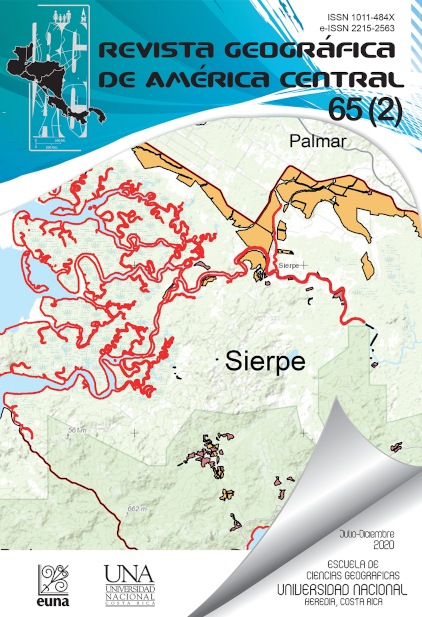Differentiation of agricultural lands in the municipality of Tequisquiapan, Querétaro
DOI:
https://doi.org/10.15359/rgac.65-2.5Keywords:
Agricultural land classes, rowth periods, Tequisquiapan, MexicoAbstract
The municipality of Tequisquiapan, state of Querétaro, Mexico, has suffered changes in land use due to urban growth. The objective of the present research is to differentiate land according to environmental conditioning and then assess and classify land types. The methodology is based on land classification guidelines as proposed by (FAO, 1997). As a result, 7 classes of land are obtained: Class I, whose limitation is semi-dry climate; Classes II and III, where soil depth is non-limiting for agricultural production. Classes IV and V, which in addition to having rocky, shallow depth soils, present a semi-dry climate and over 15% inclination that make them only suitable for grazing cattle. In classes VI and VII, the substantial stoniness (>50%) character of soils as well as greater than 25% slopes result in their recommendation as vegetation preservation land.
References
Aguilar S, G. y Estrada B.J. (1982). Perdidas de suelo en México. Chapingo, 79-84.
Aguilar Sánchez, G. (1995). Diferenciación agroclimática de la región Queréndaro-Morelia, Michoacán, México. México, DF: Insituto de Geografía-UNAM.
Bautista, F. (2016). Zonificaciòn agroclimatica de la región de infiernillo. Biodiversidad del estado de Michoacán. México, DF.: CONABIO.
Becerra Moreno, A. (1999). Escorrentía, erosión, y conservación de suelos. Texcoco, Estado de México: UACh.
Colegio de Postgraduados (1991). Manual de predicción de perdidas de suelo por erosión. México, DF: SARH.
CONAGUA (14 de Agosto de 2016). www.conagua.gob.mx. Obtenido de CONAGUA.
Edo de Qurètaro. (18 de Septiembre de 2016). Querétaro está entre nosotros. Recuperado de http://www.queretaro.gob.mx/municipios.aspx. Obtenido de queretaro.gob.
FAO. (1997). Boletín de suelos de la FAO: Zonificación agroecologica. Roma Italia: ONU.
Fernández Reynoso, D. S. (2015). Estimación de la erosión del suelo. Texcoco, Edo. Mèxico: UACh.
Granados R., R. T. (2004). Aptitud agroclimatica en la Mesa Central de Guanajuato, México. México, DF: Intituto de Geografía-UNAM.
INAFED (2010). Enciclopedia de municipios. Tequisquiapan. Querétaro, Qro.: Edo.Qro.
INEGI (1995). Sìntesis geogràfica del estado de Querètaro. México, DF: Inegi.
INEGI (2005). Uso potencial del suelo. Aguascalientes, Ags: INEGI.
INEGI (2015). Anuario estadístico y geográfico del estado de Querétaro. México: INEGI.
Lafuente, C. (2008). Metodologías de la investigación en las ciencias sociales: fases,fuentes y selección de temas. México: Escuela de Administración de Negocios.
Matías, L. F. O. &. G. F. Centro Nacional de Prevención de Desastres (2001). Heladas. Ciudad de México.
Ortiz, C., & Cuanalo, H. (1984). Metodología del Levantamiento Fisiográfico, un sistema de clasificación de tierra. Texcoco, México: COLPOS.
Pájaro, D. (1988). Estimación del Periodo de Crecimiento por disponibilidad y libre de herladas para la República Mexicana. Estado de México: Colegio de Postgraduados: Centro de Edafología.
Rojas, S. (2012). Métodos para la investigación social. México D.F: Plaza y Valdés.
Romero Peñaloza, J. (1992). El condicionamiento ambiental y el anàlisis regional de la agricultura; una experiencia. Texcoco, estado de México: Direcciòn de Centros Regionales-UACh.
Romero, P.J. (2003). Agricultura y recursos naturales en la cuenca del lago de Cuitzeo, Michoacán. Cuaderno de Centro Regionales No. 25. Chapingo, México.: DCRU-UACH,.
Sánchez, F.(24 de Noviembre de 2016 Noviembre ). Cálculo de la Precipitación areal mediante Sistemas de Información Geográfica. [En línea] Recuperado de: http://api.eoi.es/api_v1_dev.php/fedora/asset/eoi:45221/componente45219.pdf . Obtenido de /api.eoi.es.
SEDEA-Qro. (15 de 7 de 2018). Recuperado de www. sedea.queretaro.gob.mx/regiones. Obtenido de sedea queretaro.
SIAP., 2003-2015 (15 de agosto de 2016). SIAP 2003-2015. Recuperado de www.Servicio de Información Agroalimentaria.. Obtenido de www. infosiap.gob.mx/agricola siao gb/ientidad/index.jsp.inade
UNAL (2016). Marco conceptual de la erosión. Bogota, Colombia: Uni.Nal. de Colombia.
Universidad Autonòma de Querétaro. (1995). Enciclopedia Temática del Estado de Querétaro, Tomo 1 Geografìa de Querétaro. Mèxico, DF. Talleres de Artículos Gráficos de México, S.A.
USDA.. (1962). Land-capability Classification,Soil Conservation Service U.S. Washington:: Departament of Agriculture.
Wischmeir, W. A. (1978). Predicting rainfall erosionlosses a guide to conservation planning. Whasington D.C.: USDA.
Downloads
Published
How to Cite
Issue
Section
License
Proposed policy for journals offering Open Access
Authors publishing their works in the Journal acknowledge and agree to the following terms:
a) Authors retain the copyrights to their works and guarantee the Journal the right to be the first to publish their works, under the Creative Commons License Attribution-NonCommercial-ShareAlike 4.0 International, CC BY-NC-SA 4.0 International (https://creativecommons.org/licenses/by-nc-sa/4.0/deed.es), which allows others to share works upon complying with the acknowledgment of authorship and mention of the Journal as the original publisher of the work.
b) Authors are permitted to separately establish additional agreements for the non-exclusive distribution of the official edition of the work published in the Journal (for example, authors may desire to place the work in an institutional repository or incorporate it into a book that is to published elsewhere) so long they acknowledgment to recognize the Journal as the original publisher. The aforementioned additional agreements must respect the terms of the non-profit character and sharing philosophy of the original license (CC BY-NC-SA 4.0 International, https://creativecommons.org/licenses/by-nc-sa/4.0/deed.es).
c) Authors are encouraged to archive the post-print or editor/PDF version in Open Access repositories.






 REVGEO is licensed under https://creativecommons.org/licenses/by-nc-sa/4.0/deed.es
REVGEO is licensed under https://creativecommons.org/licenses/by-nc-sa/4.0/deed.es
.svg_4.png)

_(1).png)
_(1)_(1)_(1)_1.png)
(2)(1)(1)(1).png)
